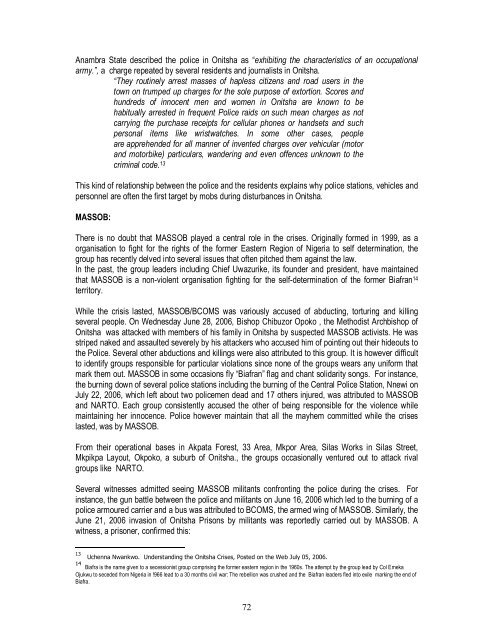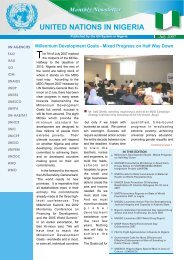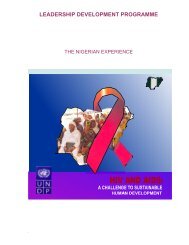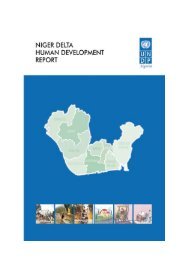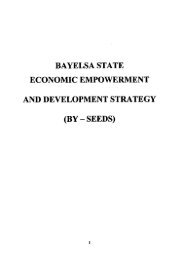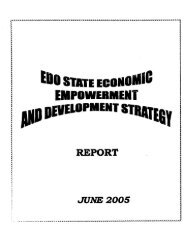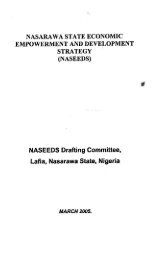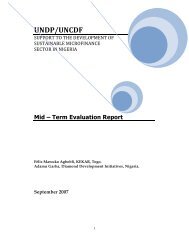THE STATE OF HUMAN RIGHTS IN NIGERIA 2005 - UNDP Nigeria ...
THE STATE OF HUMAN RIGHTS IN NIGERIA 2005 - UNDP Nigeria ...
THE STATE OF HUMAN RIGHTS IN NIGERIA 2005 - UNDP Nigeria ...
Create successful ePaper yourself
Turn your PDF publications into a flip-book with our unique Google optimized e-Paper software.
Anambra State described the police in Onitsha as “exhibiting the characteristics of an occupationalarmy.”, a charge repeated by several residents and journalists in Onitsha.“They routinely arrest masses of hapless citizens and road users in thetown on trumped up charges for the sole purpose of extortion. Scores andhundreds of innocent men and women in Onitsha are known to behabitually arrested in frequent Police raids on such mean charges as notcarrying the purchase receipts for cellular phones or handsets and suchpersonal items like wristwatches. In some other cases, peopleare apprehended for all manner of invented charges over vehicular (motorand motorbike) particulars, wandering and even offences unknown to thecriminal code. 13This kind of relationship between the police and the residents explains why police stations, vehicles andpersonnel are often the first target by mobs during disturbances in Onitsha.MASSOB:There is no doubt that MASSOB played a central role in the crises. Originally formed in 1999, as aorganisation to fight for the rights of the former Eastern Region of <strong>Nigeria</strong> to self determination, thegroup has recently delved into several issues that often pitched them against the law.In the past, the group leaders including Chief Uwazurike, its founder and president, have maintainedthat MASSOB is a nonviolent organisation fighting for the selfdetermination of the former Biafran 14territory.While the crisis lasted, MASSOB/BCOMS was variously accused of abducting, torturing and killingseveral people. On Wednesday June 28, 2006, Bishop Chibuzor Opoko , the Methodist Archbishop ofOnitsha was attacked with members of his family in Onitsha by suspected MASSOB activists. He wasstriped naked and assaulted severely by his attackers who accused him of pointing out their hideouts tothe Police. Several other abductions and killings were also attributed to this group. It is however difficultto identify groups responsible for particular violations since none of the groups wears any uniform thatmark them out. MASSOB in some occasions fly “Biafran” flag and chant solidarity songs. For instance,the burning down of several police stations including the burning of the Central Police Station, Nnewi onJuly 22, 2006, which left about two policemen dead and 17 others injured, was attributed to MASSOBand NARTO. Each group consistently accused the other of being responsible for the violence whilemaintaining her innocence. Police however maintain that all the mayhem committed while the criseslasted, was by MASSOB.From their operational bases in Akpata Forest, 33 Area, Mkpor Area, Silas Works in Silas Street,Mkpikpa Layout, Okpoko, a suburb of Onitsha., the groups occasionally ventured out to attack rivalgroups like NARTO.Several witnesses admitted seeing MASSOB militants confronting the police during the crises. Forinstance, the gun battle between the police and militants on June 16, 2006 which led to the burning of apolice armoured carrier and a bus was attributed to BCOMS, the armed wing of MASSOB. Similarly, theJune 21, 2006 invasion of Onitsha Prisons by militants was reportedly carried out by MASSOB. Awitness, a prisoner, confirmed this:13Uchenna Nwankwo. Understanding the Onitsha Crises, Posted on the Web July 05, 2006.14Biafra is the name given to a secessionist group comprising the former eastern region in the 1960s. The attempt by the group lead by Col EmekaOjukwu to seceded from <strong>Nigeria</strong> in !966 lead to a 30 months civil war: The rebellion was crushed and the Biafran leaders fled into exile marking the end ofBiafra.72


